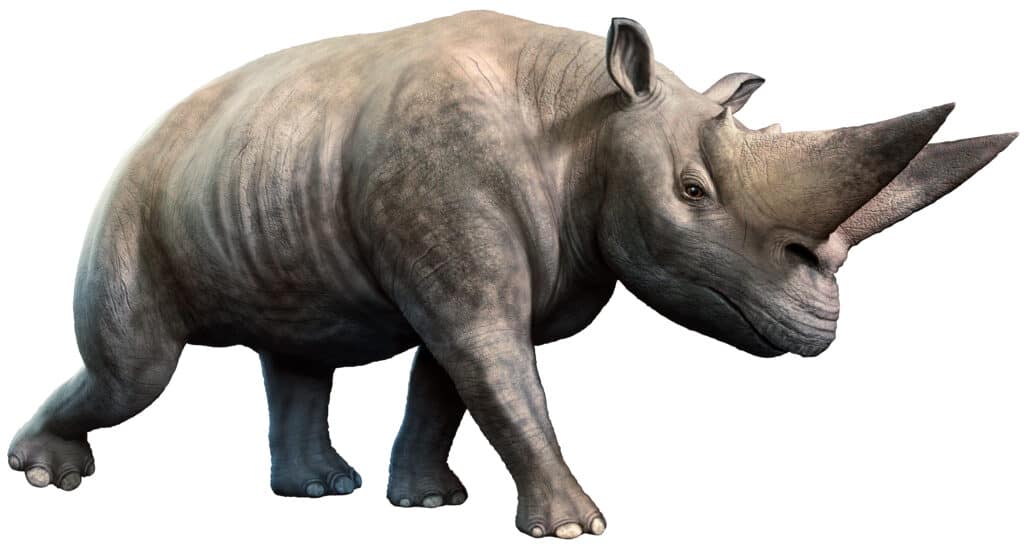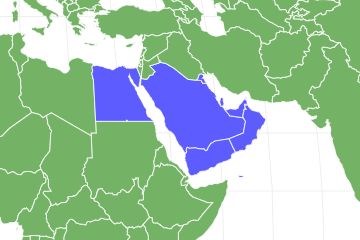Arsinoitherium
Arsinoitherium
Arsinoitherium was a twin-horned mammal that looked like a rhino but is more closely related to present-day elephants.
Advertisement
Arsinoitherium Scientific Classification
- Kingdom
- Animalia
- Phylum
- Chordata
- Class
- Mammalia
- Order
- Embrithopoda
- Family
- Arsinoitheriidae
- Genus
- Arsinoitherium
- Scientific Name
- Arsinoitherium
Read our Complete Guide to Classification of Animals.
Arsinoitherium Conservation Status
Arsinoitherium Facts
- Fun Fact
- Arsinoitherium was a twin-horned mammal that looked like a rhino but is more closely related to present-day elephants.
- Most Distinctive Feature
- The Arsinoitherium had two horns on its head.
- Distinctive Feature
- Columner limbs like that of an elephant
View all of the Arsinoitherium images!
Arsinoitherium was a twin-horned mammal that looked like a rhino but is more closely related to present-day elephants. This extinct genus lived in Africa and on the Arabian peninsula between the Late Eocene and Middle Oligocene periods (between 45 to 24 million years ago). Arsinoitherium is a genus of paenungulata mammals (almost hoofed mammals) along with living species like the elephants, manatees, and hyraxes.
Description & Size
Arsinoitherium is a genus of extinct large mammals known from deposits from the Eocene Epoch about 56 million to 34 million years ago. A more recent discovery in other locations shows that members of the genus survived into the Oligocene Epoch about 34 million to 23 million years ago.
The genus Arsinoitherium was named after Queen Arsinoe I of Ancient Egypt. The Faiyum Oasis, where the first fossils of the genus were discovered, is named after her. The genus name is a reference to this fact. Arsinoitherium belongs to the order Embrithopoda, which is now extinct. Two well-known species in the genus include Arsinoitherium zitteli and Arsinoitherium giganteus.
As far as appearance goes, Arsinoitherium is often described as a fanciful rhinoceros. It had two large horns on the nasal bones and a smaller pair on the frontal bones. The size of this mammal is also comparable to that of a large white rhinoceros. The arsinoitherium reached lengths of up to 3.5 meters (11 feet). They stood at about 1.75 m (5.7 ft) tall at the shoulders.
The bone structure of Arsinoitherium is quite similar to that of elephants. They had elephant-like hips, feet, and skulls. Their twin horns, which could grow to up to 2.5 feet in length, were hollow and made of a bony material like that of modern cows. The horns probably had a keratin sheet which would have protected them from fracturing. Both males and females had horns, but some experts have theorized that they exhibited sexual dimorphism in terms of size.

Arsinoitherium’s horns were hollow.
©Warpaint/Shutterstock.com
Diet – What Did Arsinoitherium Eat?
Arsenoitherium was a browsing herbivore. However, judging from the specialized tooth design and jaw muscles, palaeontologists think it had a selective diet. It may have eaten bulky fruits and grasses that were abundant in the Fayoum Oasis site in Egypt, where it was found.
Habitat – When and Where It lived
Members of the Arsinoitherium genus were massive, slow-moving mammals. The widely-held belief is that they lived in swamps and semi-aquatic areas like modern hippos. Their forelimbs were adapted for pulling strongly backward instead of swinging forward. This feature is typical of animals that tend to pull themselves through shallow water, marshlands and other forms of sticky ground.
Most of the fossils found so far were in sediments indicative of a coastal swamp environments or warm, humid low-land forests with a lot of vegetation. The Arsinoitherium was one of the largest mammals in Africa and the Arabian Peninsula from the Late Eocene into the Middle Oligocene.
Threats And Predators
Considering the massive size of these mammals, they did not have any major predators that could prey on them. Scientists think Arsinoitherium’s limbs weren’t adapted for moving fast because it didn’t have to run since it did not have any predator that would attack it.
Discoveries and Fossils – Where It Was Found
Paleontologists found the first fossils of Arsinoitherium in the Jebel Qatrani formation in the Fayum Oasis of Egypt. This site had complete skeletons of this mammal in Late Eocene to Early Oligocene sediments.
Paleontologist H. L. Beadnell discovered the fossil in 1901 and assigned the name Arsinoitherium zitteli to it about a year later. The genus Arsinoitherium means Arsinoe’s Beast, a reference to Queen Arsinoe I of Egypt. A. zitteli is the best-known species in this genus.
A newer and larger species was discovered more recently. In 2004, paleontologists working in the Chilga region of Ethiopia discovered new fossils belonging to a species of Arsinoitherium. Based on tooth comparison, the newly-discovered species was roughly 25% larger than A. zitelli. It got the name Arsinoitherium giganteus.
In addition to these notable finds, paleontologists have found several fossil fragments (mainly teeth) that belong to an uncertain species in the genus. scientists have found fossil fragments of this uncertain specie of Arsinoitherium in various locations across Africa and the Middle East.
Extinction – When Did Arsinoitherium Die Out?
Arsinoitheriums became extinct about 27 million years ago. Like most of the other large mammals that lived at the time, scientists have theorized that climate change was the major cause of their extinction.
Drastic changes in climatic conditions during the Late Eocene led to a disruption of Arsinoitherium’s habitat. The weather shifted from hot and humid to a much colder one. This led to the loss of their wet forested habitat and the rise of grasslands and savannahs, which is now prominent in most parts of Africa.
A few Arsinoitherium survived within a small range of forested environments for a while. However, as the cooling persisted, grasslands spread across Northern Africa. By the Middle Oligocene, the Arsinoitherium had lost their habitat and food source completely, leading to their disappearance.
Similar Animals To Arsinoitherium
Similar animals to Arsinoitherium include:
- White Rhinoceros – This two-horned mammal is the second largest animal on land and at top speed can exceed 30 miles per hour.
- Elephant – In addition to being one of the smartest animals on the planet, elephants are also one of the strongest as they can carry up to 7 tons.
Arsinoitherium FAQs (Frequently Asked Questions)
Was arsinoitherium a rhino?
No, despite the giant twin horns of this mammal that gave it the appearance of a rhino, it was not a rhino at all. Instead, this genus of paenungulata mammals is more closely related to elephants and manatees.
When did arsinoitherium go extinct?
The last of the arsinoitherium disappeared about 27 million years ago. The drastic shift in climate from warm and humid to cold during the Eocene epoch led to the disappearance of their habitat and regular food source.
What does the name arsinoitherium mean?
The genus name means Arsinoe’s Beast, in reference to Queen Arsinoe I of Egypt. The valley where the mammal’s fossils were first discovered was named after her by her husband, Pharaoh Ptolemy II.
Was arsinoitherium a dinosaur?
No, arsinoitherium is not a dinosaur. It is a genus of mammals that lived long after the dinosaurs disappeared.
When was arsinoitherium alive?
Arsinoitherium lived between the Eocene and the Early Oligocene period. This was about 36 to 30 million million years ago.
How big was arsinoitherium?
An adult arsinoitherium would have been roughly the same size as a present-day rhinoceros. They stood at a height of about 1.75 m (5.7 ft) tall at the shoulders and were about 3m (9.8 ft) long.
Thank you for reading! Have some feedback for us? Contact the AZ Animals editorial team.
Sources
- Fossil Guy / Accessed September 5, 2022
- Britannica/The Editors of Encyclopaedia / Published October 12, 2018 / Accessed September 5, 2022
- Wikipedia / Published August 22, 2022 / Accessed September 5, 2022


















